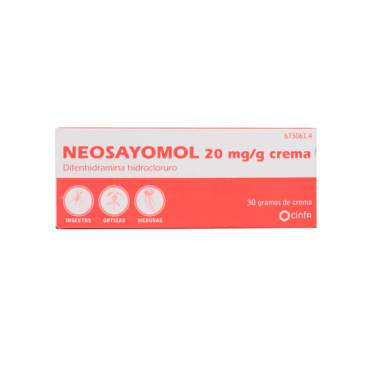Neosayomol 20 Mg/G Cream 30 G
Neosayomol is a cream composed of an antihistamine, diphenhydramine, which is effective in relieving itching in allergic conditions.
This medicine is indicated for adults and children over 6 years of age for the symptomatic local relief of itching and stinging of skin of allergic origin, caused by insect, nettle or jellyfish stings.
Neosayomol is a cream composed of an antihistamine, diphenhydramine, which is effective in relieving itching in allergic conditions.
This medicine is indicated for adults and children over 6 years of age for the symptomatic local relief of itching and stinging of skin of allergic origin, caused by insect, nettle or jellyfish stings.
Neosayomol 2% Cream 30 G
You can buy Neosayomol Cream online from UK, Austria, Belgium, Cyprus, Estonia, Finland, France, Deutsch / Germany, Greece, Ireland, Italy, Latvia, Lithuania, Luxembourg, Malta, the Netherlands, Portugal, Slovakia and Slovenia
ACTION AND MECHANISM
- [ANTIALERGIC], [HISTAMINERGIC ANTAGONIST (H-1)]. Diphenhydramine is a derivative of ethanolamine, which competitively, reversibly and non-specifically blocks the H1 receptors, decreasing the systemic effects of histamine. It leads to vasoconstriction and decreased vascular permeability, reducing redness and edema associated with allergy. Mitigates partially symptoms associated with allergic processes such as eye redness or nasal congestion. It also produces a decrease in dermal pruritus.
PHARMACOKINETICS
- Topical route: At the recommended dose only a very small amount of the active ingredients will be absorbed. The percutaneous absorption of diphenhydramine has not been quantified nor are there specific data on its pharmacokinetics.
INDICATIONS
- Symptomatic relief of [PURITY] of the skin due to [INSECT STINGS], contact with jellyfish or nettles, etc.
POSOLOGY
DOSAGE:
- Topical route: Adults and children over 6 years old; Apply a small amount of Neosayomol cream on the affected area up to 3-4 times a day. If the symptoms persist for more than 7 days or get worse, stop the treatment and consult the doctor.
RULES FOR THE CORRECT ADMINISTRATION
- Thoroughly clean the affected area, let dry and gently spread a small amount of Neosayomol cream on the affected area of the skin. Wash hands after application.
CONTRAINDICATIONS
- Hypersensitivity to any component of the medication. There may be cross reactions with other antihistamines, so it is not recommended to use any antihistamine H1 in patients who have presented hypersensitivity to any compound in the group.
PRECAUTIONS
- Avoid its application on eroded skin, bleeding, with [AMPOLLAS], [WOUNDS] or exudates, since there could be a percutaneous absorption producing systemic effects.
- Diphenhydramine could give rise to [PHOTOSENSITIVITY REACTIONS], so it is recommended not to sunbathe during the treatment, and to be protected by sunscreen.
- [PORFIRIA]. Antihistamines H1 have been associated with the appearance of porphyric outbreaks, so they are not considered safe in these patients.
WARNINGS ON EXCIPIENTS:
- Because it contains butyl hydroxyanisole as an excipient, it can produce local reactions on the skin, such as contact dermatitis, or irritation of the eyes or mucous membranes.
PATIENT TIPS
PATIENT TIPS:
- Protect the area of application to sunlight to avoid photosensitivity reactions.
- Assessment by the pediatrician on the use of diphenhydramine in children under 6 years.
- If symptoms persist for more than 7 days or aggravate, stop treatment and consult a doctor.
- Use only for external use on the skin. Do not use over large areas to avoid systemic absorption.
- Avoid contact with eyes and mucous membranes.
INTERACTIONS
- It could enhance the photosensitizing effects of other active ingredients that give rise to photosensitivity reactions.
PREGNANCY
- It is not known if diphenhydramine can be absorbed topically. No adequate and well-controlled studies have been conducted in humans, so the use of this medicine is only accepted if the potential benefits outweigh the possible risks and as long as there are no safer therapeutic alternatives.
LACTATION
- It is not known whether topical diphenhydramine is absorbed in sufficient quantity to be excreted in breast milk, nor are its possible adverse effects on the infant known.
CHILDREN
- The use of diphenhydramine in children under six years of age is not recommended, especially in neonates and infants.
ADVERSE REACTIONS
The side effects of diphenhydramine are usually mild and transient, being more frequent during the first days of treatment. There is great interindividual variability with respect to the frequency and intensity of symptoms, affecting especially young and old children.
The most common adverse reactions are:
* Allergic / dermatological. Rarely, [HYPERSENSITIVITY REACTIONS] may appear after topical administration. [PHOTOSENSITIVITY REACTIONS] may also appear after intense exposure to sunlight, with [CONTACT DERMATITIS], [PRURITE], [EXANTEMATIC ERUPTIONS] and [ERYTHEMA].
OVERDOSE
- Symptoms: Accidental ingestion or excessive topical absorption through the skin can produce signs related to the toxicity of diphenhydramine. This includes sedation, drowsiness and anticholinergic symptoms. At high doses may appear coma, ataxia, increased muscle reflexes and seizures.
- Treatment: Rapid evacuation of the product should be carried out by means of a stomach wash or aspirate or inducing vomiting. In case of acute poisoning, activated charcoal should be used. Seizures can be controlled with diazepam.
Chris D. published the 16/07/2024 following an order made on 27/06/2024
Super
Anonymous customer published the 29/09/2018 following an order made on 29/09/2018
Very good contact and the transfer to Sweden was perfect. Thank you so much!




